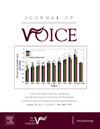针对模拟交流要求的发声力度自我感知。
IF 2.5
4区 医学
Q1 AUDIOLOGY & SPEECH-LANGUAGE PATHOLOGY
引用次数: 0
摘要
目的:优化发声力度以满足发声要求是临床和发声表演的共同目标。发声力度的增加通常是为了应对来自对话者和交流环境的限制。本研究调查了发声力度与交流环境变化和限制所产生的发声要求之间的关系:方法:37 名参与者在不同的交流要求下对其与地图描述任务相关的发声努力程度进行了评分。这些要求包括交流距离(从 1 米到 4 米)、响度目标(54 分贝-66 分贝)和过量背景噪音(53 分贝-71 分贝)。在不同类型和程度的发声要求条件下,对发声努力程度进行了比较:正如预期的那样,从对照条件到距离和响度目标发声要求的极端条件,发声努力程度都有显著增加。背景噪音的每次增加都会导致发声努力水平的明显提高。参与者能够使用发声努力量表有效地量化发声要求的预期增加:结论:发声努力程度的增加伴随着发声需求的增加,而发声需求的增加超出了习惯或预期的交流。虽然嗓音训练和嗓音治疗对减少内部发声需求至关重要,但以减少发声努力为目标的客户还应考虑外部发声需求,如交流距离和背景噪音。本文章由计算机程序翻译,如有差异,请以英文原文为准。
Self-Perception of Vocal Effort in Response to Modeled Communication Demands
Objectives
The optimization of vocal effort given a response to a voice demand is a common clinical and vocal performance goal. Increases in vocal effort are often in response to communication limitations from both the interlocutors and the communication environment. This study investigates the relationship between vocal effort and vocal demands from changes and limitations imposed by the communication environment.
Methods
Thirty-seven participants rated their vocal effort associated with a map description task in a range of communication demands. These demands included communication distance (from 1 m to 4 m), loudness goal (54 dB–66 dB), and excess background noise (53 dBA–71 dBA). The vocal effort ratings were compared across the different types and extents of vocal demand conditions.
Results
As would be expected, there were significant increases in vocal effort levels from the control condition to the extremes of the distance and loudness goal vocal demands. Each increase in background noise resulted in distinct increases in vocal effort level. Participants were able to use the vocal effort scale to efficiently quantify expected increases in vocal demands.
Conclusions
Increases of vocal effort level accompany increases to vocal demands that exceed the habitual or expected communication. While voice training and vocal therapy are essential for reducing internal vocal demands, clients with a goal to reduce vocal effort should also consider external vocal demands such as communication distance and background noise.
求助全文
通过发布文献求助,成功后即可免费获取论文全文。
去求助
来源期刊

Journal of Voice
医学-耳鼻喉科学
CiteScore
4.00
自引率
13.60%
发文量
395
审稿时长
59 days
期刊介绍:
The Journal of Voice is widely regarded as the world''s premiere journal for voice medicine and research. This peer-reviewed publication is listed in Index Medicus and is indexed by the Institute for Scientific Information. The journal contains articles written by experts throughout the world on all topics in voice sciences, voice medicine and surgery, and speech-language pathologists'' management of voice-related problems. The journal includes clinical articles, clinical research, and laboratory research. Members of the Foundation receive the journal as a benefit of membership.
 求助内容:
求助内容: 应助结果提醒方式:
应助结果提醒方式:


